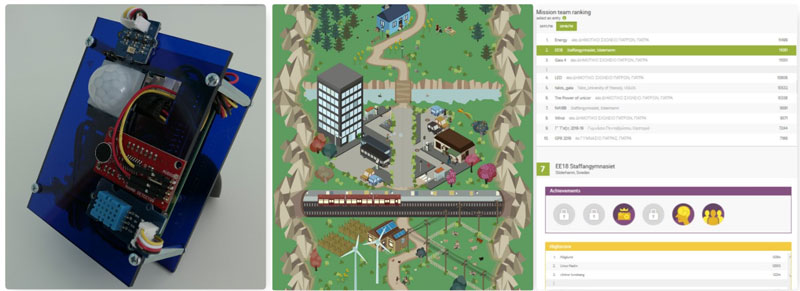by Georgios Mylonas (Computer Technology Institute & Press “Diophantus”) and Ioannis Chatzigiannakis (Sapienza University of Rome)
Today’s students are the citizens of tomorrow, and they should have the skills and tools to understand and respond to climate change. Green Awareness in Action (GAIA) has built an IoT infrastructure within 25 schools in Europe, in order to enable lectures that target sustainability and energy efficiency, based on data produced inside school buildings. The school community has reacted very positively to this approach and has reduced energy consumption as a consequence.
GAIA [L1], a Horizon2020 EC-funded project, has developed a large-scale IoT infrastructure in a number of school buildings in Europe. Its primary aim is to raise awareness about energy consumption and sustainability, based on real-world sensor data produced inside the school buildings where students and teachers live and work.
Overall, 25 educational building sites participated in GAIA, located in Sweden, Italy and Greece. The IoT infrastructure installed in these buildings monitors in real-time their power consumption, as well as several indoor and outdoor environmental parameters. However, this infrastructure would not be particularly useful without a set of tools to allow access to the data produced and provide functionality to support educational activities. The GAIA Challenge [L2] is a playful interactive platform aimed at students, designed to serve as an introduction to power consumption and energy saving. In addition, real-time data from sensors in the buildings and participatory sensing help to visualise the real-life impact of the students’ behaviour and enable competitive gamification elements among different schools. The GAIA Building Manager online application offers visualisation of energy and environmental data.
The GAIA Challenge has been a success in GAIA’s software portfolio, with over 3,750 registered students and teachers using it as an introduction to sustainability and energy efficiency concepts. The end-user audience of GAIA has largely comprised primary and junior high school students, but some high school and technical college students as well. This variability in students’ age and origin has led to the use of a range of different approaches when applying GAIA’s tools within educational activities.
The project completed its official activities in May 2019. One of its biggest achievements was the construction of an operational and reliable large-scale IoT infrastructure within 25 school buildings in Greece, Italy and Sweden. This infrastructure [2] includes over 1,200 sensing endpoints, which have been based on open-source components. By combining the tools and project methodology with data produced inside school buildings during related activities in the schools, we have energy savings of up to 15-20 %.
An important factor to encourage engagement is competition: students were intrigued by the prospect of competing with other schools and countries, and were further motivated to participate in GAIA’s competitions for energy savings and related ideas. The project also held two official competitions between schools during educational years 2017-18 and 2018-19, which proved a valuable tool in motivating and engaging the schools participating in the project.
Following GAIA’s completion, the network of schools built during the project, as well as the software tools developed, will continue to be active in the following school year (2019-2020). The consortium members will collaborate with other research teams and contribute to the community in this field via sharing datasets for experimental evaluation. There are also methodologies and educational activities available on the project website [L1], offering the opportunity to replicate the results of the project to any school/team wishing to do so.

Figure 1: Some of the basic elements in the GAIA approach (from left to right): an IoT node installed inside classroom measuring environmental parameters, the world map of the GAIA Challenge on top of which students move between GAIA’s “missions”, and the ranking of different schools and classes participating in the Challenge.
This work has been supported by the EU research project “Green Awareness in Action” (GAIA), funded by the European Commission and the EASME under H2020 and contract number 696029.
Links:
[L1] http://gaia-project.eu/
[L2] https://gaia-challenge.com/
References:
[1] G. Mylonas, et al.: “Enabling Energy Efficiency in Schools based on IoT and Real-World Data”, in IEEE Pervasive Computing, Vol. 17, Issue: 4, 2018, https://doi.org/10.1109/MPRV.2018.2873855
[2] D. Amaxilatis, et al.: “An IoT-based solution for monitoring a fleet of educational buildings focusing on energy efficiency”, in MDPI Sensors, Special Issue in Advances in Sensors for Sustainable Smart Cities and Smart Buildings, 17(10): 2296, https://doi.org/10.3390/s17102296
[3] G. Mylonas, et al.: “An educational IoT lab kit and tools for energy awareness in European schools”, Int. Journal of Child-Computer Interaction, Vol. 20, 2019, pp. 43-53, ISSN 2212-8689, https://doi.org/10.1016/j.ijcci.2019.03.003.
Please contact:
Georgios Mylonas
Computer Technology Institute & Press “Diophantus”, Greece











